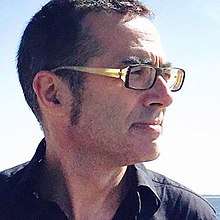Dominique Kalifa
Dominique Kalifa is a French historian, professor at the University of Paris 1 Pantheon-Sorbonne, where he is director of the Centre of 19th Century History[1][2] and member of the Institut Universitaire de France. A student of Michelle Perrot, he specialises in the history of crime, transgression, social control, and mass culture in 19th and early 20th France and Europe. He also taught at the Institut d'Etudes Politiques de Paris (Sciences Po) from 2008 to 2015, and was several times "Invited professor" at NYU and "Visiting Scholar" at the University of Saint Andrews. From 1990, he is also columnist (historical reviews) for the French newspaper Libération. His study about the underworld and its role in the Western imagination is now translated into portuguese (EDUSP), Spanish (Mora) and forthcoming in English (Columbia University Press). His Véritable Histoire de la Belle Epoque, published in 2017, won the Eugene Colas Prize from the Académie Française. He is currently working on a new project about love, Paris and the topographical imagination.

Books
- L’Encre et le Sang. Récits de crimes et société à la Belle Époque, Fayard, Paris, 1995.
- Naissance de la police privée, Plon, Paris, 2000.
- La Culture de masse en France, tome 1 1860–1930, La Découverte, Paris, 2001.
- Vidal le tueur de femmes. Une biographie sociale (with Philippe Artières), Perrin, Paris, 2001.
- Imaginaire et sensibilités au XIXe siècle (with Anne-Emmanuelle Demartini), Creaphis, Paris, 2005.
- Crime et culture au XIXe siècle, Perrin, Paris, 2005.
- L'Enquête judiciaire en Europe au XIXe siècle (ed), Creaphis, Paris, 2007.
- Le Commissaire de police au XIXe siècle (ed), Publications de la Sorbonne, 2008.
- Crimen y cultura de masas en Francia, siglos XIX-XX, Instituto Mora, Mexico, 2008.
- Biribi. Les bagnes coloniaux de l'armée française, Paris, Perrin, 2009.
- La Civilisation du journal. Histoire culturelle et littéraire de la presse au XIXe siècle (ed), Nouveau Monde, Paris, 2011.
- Les bas-fonds. Histoire d'un imaginaire, Seuil, Paris, 2013.
- Atlas du crime à Paris, du Moyen Age à nos jours (with J.-C. Farcy), Paris, Parigramme, 2015.
- La Véritable Histoire de la Belle EPoque, Paris, Fayard, 2917.
- Tu entreras dans le siècle en lisant Fantômas, Paris, Vendémiaire, 2017.
- Paris. Une histoire érotique d'Offenbach aux sixties, Paris, Payot, 2018.
In English : “Crime Scenes: Criminal Topography and Social Imaginary in Nineteenth Century Paris”, French Historical Studies, vol. 27, n° 1, 2004, p. 175-194 ; “Criminal Investigators at the Fin-de-siècle”, Yale French Studies, n° 108, 2005, p. 36-47 ; “What is now cultural history about?”, in Robert Gildea and Anne Simonin (eds), Writing Contemporary History, London, Hodder Education, 2008, p. 47-56; « The Press », in E. Berenson, V. Duclert & C. Prochasson (eds), The French Republic. History, Values, Debates, Ithaca, Cornell University Press, 2011, p. 189-196; “Minotaur”, Journal of Modern History, vol. 84, n° 4, 2012, p. 980-982; "Naming the Century: Chrononyms of the 19th Century", Revue d'histoire du XIXe siècle, n° 52, 2016 [3] ; “An Informal History of Herbert Asbury's Underworld“, Medias19, 2018 [4]; Vice, Crime, and Poverty. How the Western Imagination Invented the Underworld, Columbia University Press, 2019.
References
- Lagadic, Université Paris 1 Panthéon-Sorbonne - Marc-Olivier. "Université Paris 1 Panthéon-Sorbonne: CRHXIX - Centre d'histoire du XIXe siècle (EA 3550)". crhxix.univ-paris1.fr.
- "Archived copy". Archived from the original on 2011-07-21. Retrieved 2011-03-09.CS1 maint: archived copy as title (link)
- Kalifa, Dominique; Holding, Robin. "Introduction. Naming the Century: The Nineteenth Century and its 'Chrononyms'". Revue d'histoire du XIXe siècle. No 52 (1).
- "The Informal History of Herbert Asbury's Underworld".